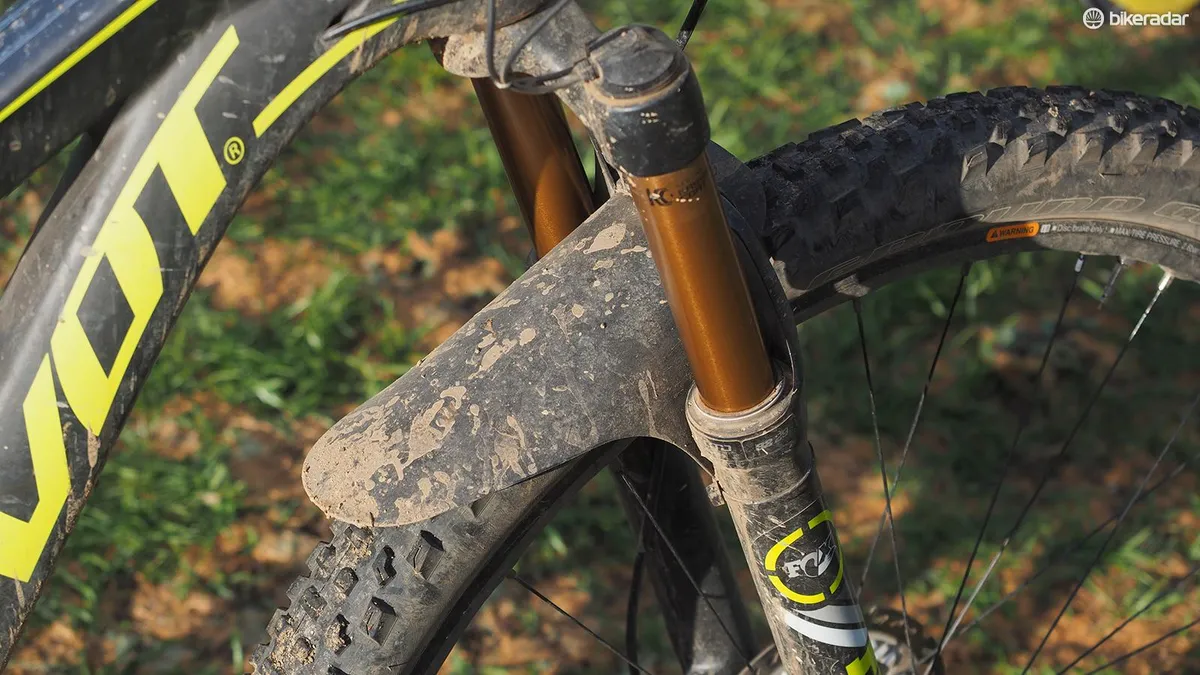To say that I’m not a huge fan of climbing would be quite the understatement so when I hit the ‘confirm’ button on the registration page for multi-stage MTB race the Breck Epic, I had instant second thoughts. Why on earth was I doing a six-day mountain bike stage race across Colorado with nearly 10,000m (32,600ft) of vertical?
Whatever reservations I had, however, were quickly erased when I suddenly remembered that all climbing comes with a lot of descending, and I quickly set to the task of laying out a bike to suit. This was going to be big-time fun.
- The course: The Breck Epic, a six-day mountain bike stage race in the Colorado high country covering more than 400km (250mi) of distance and 10,000m (32,600ft) of climbing, all above 3,000m (10,000ft) of elevation.
- The equipment goal: A full-suspension 29er that was suitable for hours of climbing but still tough (and fun) enough for lots of demanding, high-speed descending.
- The horse: A custom-built Pivot Mach 429SL trail bike with Fox iCTD electronic suspension, a Shimano XTR Di2 2x11 transmission, wide-but-light wheels and tyres, and a KS carbon fibre dropper post

This was going to hurt - but it was also going to be extremely fun
It’s not just about going uphill
Long mountain bike races are invariably won on the climbs. They occupy the biggest percentage of the total time, they quickly separate the fit from the unfit, and they require the most preparation beforehand to do well.
That said, I knew that I wasn’t exactly going to be gunning for a podium spot. While normal logic would dictate maximising my vertical rate of ascent with ultralight gear, I instead started thinking about the grin on my face for all that descending. Breck Epic would serve up a whole lot of it, too, and in massively big, fat chunks. As long as I could get myself up there with enough left in the tank to enjoy the ride down, I’d be in good shape.

What goes up must eventually come down
In light of that, I passed over the ultralight hardtails most serious contenders were using and instead decided to use a XC-minded full-suspension 29er, set up with trail riding in mind. As I conveniently also had a Shimano XTR Di2 electronic transmission I needed to test, Pivot’s Di2-ready Mach 429SL was an easy choice. Lighter than the previous Mach 429 by about 200g and equipped with an efficient 100mm-travel dw-link suspension system, I figured it’d be a perfect choice.
I further electrified the build with Fox iCTD suspension components at either end (with 120mm of travel up front), and since I’ve long ago decided that dropper posts are requisite equipment for any serious mountain bike ride, I went with KS’s new LEV Integra C model with its lightweight carbon fibre body and short (but still useful) 65mm of travel.

The rear suspension on the Pivot Mach 429SL is perfectly suited for the intended task
Carbon would have been a tempting choice for wheels but since much of the Breck Epic would be held in remote territory with little chance of outside help, I erred on the side of caution and went with Shimano’s new XTR Trail wheels with their 24mm-wide (internal width) tubeless-compatible aluminum rims and superbly sealed cup-and-cone hubs. Extensive experience on home trails with Specialized’s Ground Control and Fast Trak tyres made those an easy choice, too, both with reasonably durable ‘Control’ casings and generous 2.3in section widths.
Rounding out the build were matching Shimano XTR Trail brakes (with 160mm rotors and finned brake pads) and XTR Trail pedals, an Easton EC90 carbon stem and wide EC70 flat carbon bar, Specialized Enduro XL locking grips, a WTB Silverado saddle, an Arundel Sideloader carbon bottle cage, a Garmin Edge 520 computer fitted to a Bar Fly 3.0 mount, and a shiny brass Incredibell (because when you’re hypoxic, it’s easier – and friendlier – to ding a bell to signal your approach instead of trying to gasp, “On your left!”).

I went with a 2x11 Shimano XTR Di2 drivetrain for the Breck Epic
Total weight was a respectable 12.47kg (27.49lb) – hardly a featherweight all things considered but at least I wouldn’t have the burden of questionable reliability weighing on my shoulders. After a few weeks of shakedown rides, it was time to hit the starting line.
Ready, set… suffer!
Just as I fully expected, I was no rocketship on any of Breck Epic’s seemingly endless climbs but in fairness, some of that was by design. Since I wasn’t gunning for a top spot, there wasn’t much motivation to kill myself on the way up – I was saving it for the way down.
In light of that, the Mach 429SL did extremely well, dutifully clawing its way upward for hours on end, even on challenging sections that were so steep and loose that the majority of participants were forced to walk. And had I wanted to go faster, I likely could have. Just as I’d hoped, the rear end of the Mach 429SL was gloriously efficient under power with almost no bob even without the electronic rear lockout engaged.

I was really happy to have the extra 20mm of travel up front as compared to a more typical 100mm-travel XC fork
Between the excellent rear end and the low 20/22psi front/rear tyre pressures I was running, traction wasn’t an issue, either. All I had to do was settle in and grind it out – over, and over, and over again.
It was on the way down that the bike really came into its own with that generous tyre footprint tenaciously clawing at the ground, the well tuned suspension helping the bike stay confidently planted, and the stiff chassis and wheels offering up utter predictability the whole way. I regularly took the ugly line down wider sections of trail to get around fellow racers who were taking more conservative routes and gleefully jumped, hopped, and slid up and around everything I could.

Big tyre and reasonably wide rims were a great combo
Even at warp speed and on some of Colorado’s finest alpine terrain, some of these descents took nearly 20 minutes to complete – and I quickly lost track of how many people I’d pass in a stretch. Any questions I had about lugging the extra weight to the top of the climb (dropper posts, yay!) were quickly erased by unabashed glee. Seriously, when was the last time you got to descend for 20 minutes on prime singletrack?
The benefit of hindsight
As happy as I was with the majority of my equipment decisions – in particular the awesome Mach 429SL chassis – there are certainly a few things I would have done differently.
Without doubt, the Fox iCTD suspension bits are extremely impressive, switching nearly instantly between the open, platform, and locked-out modes with barely a wiggle of a finger. The included handlebar remote takes up little room on the bar but I really wished I could have repurposed a left-hand XTR Di2 shifter to do the same job given that bit’s superior ergonomics.

I really wish I could have used a left-hand XTR Di2 shifter to control the suspension instead of the stock Fox remote
More to the point, the inherently good anti-squat characteristics of the dw-link rear end made multiple suspension modes essentially unnecessary, at least out back. I would have been perfectly happy having to flick a lever atop the crown from time to time. While really neat, the iCTD bits also weigh substantially more than their non-electrified counterparts. Next time, I’ll do without.
I finished the event with similarly mixed feelings about the XTR Di2 drivetrain. The assembly of switches, wires, batteries, and motors is a technological wonder and Shimano’s Syncro Shift mode is so good that it almost makes 2x drivetrains relevant again. That said, it wasn’t perfect, dropping the chain up front a handful of times when performing double shifts while climbing. I also never completely got used to the rotary shifter’s odd paddle placement, which unfortunately can’t be adjusted to closely mimic Shimano’s standard triggers.

Hey, Shimano, how about some more range back here please?
On the plus side, though, battery life simply wasn’t an issue. I recharged the system once after stage 1 just out of precaution but as it turned out, I could have done the event twice without having to plug anything in – especially impressive given that mine was a worst-case scenario that included those iCTD suspension bits, frequently cold temperatures, and lots of front shifting.
If I do the Breck Epic again, it’ll be on a simpler wide-range 1x setup with a 10-44t (or wider) cassette, which would provide nearly all the gearing spread I need but without the additional weight and with much better chain security.

Dropper posts FTW!
Sadly, even the brakes were a bit of a letdown with only so-so power as compared to the SRAM Guides I’d been using most of the season up until then, and a lever bite point that was annoyingly inconsistent.
One for your bucket list
Keep in mind that all of these equipment complaints are prime examples of first-world problems – and arguably even 1%er ones at that. I still finished the Breck Epic with a huge smile on my face, an enormous sense of accomplishment, a lifetime’s worth of incredible mountain views, and the satisfaction of having suffered exactly zero mechanicals. Aside from the handful of dropped chains already mentioned and periodically checking tire pressures and chain lube, I literally put the bike away wet and dirty each day and then hopped on the next morning with no issues whatsoever.

The Breck Epic had long been on my bucket list but having now done it, I want to do it again - and you should, too
Would I do it exactly the same way next time? Maybe not, but I wouldn’t exactly be hating life if I passed through a wormhole and found myself at the starting line with the identical setup. It’s my job to nitpick, after all, but let’s just say that I wouldn’t be terribly upset to find one of these under my Christmas tree this year – and you wouldn’t be, either.
Either way, if you love mountain biking, you owe it to yourself to put the Breck Epic on your bucket list. It’s an event that I can now check off but I certainly hope to be back again someday.
For more information, visit www.pivotcycles.com and www.breckepic.com.
Complete bike specifications:
- Frame: Pivot Cycles Mach 429SL, 100mm-travel
- Rear shock: Fox Float iCTD
- Fork: Fox 32 Float 29 120 iCTD FIT, 120mm-travel
- Headset: 1 1/8-to-1 1/2in tapered, integrated
- Stem: Easton EC90 SL, 70mm
- Handlebar: Easton EC70, 720mm
- Grips: Specialized Enduro XL
- Front brake: Shimano XTR Trail BR-M9020 with 160mm Ice Tech rotor
- Rear brake: Shimano XTR Trail BR-M9020 with 160mm Ice Tech rotor
- Brake levers: Shimano XTR Trail BL-M9020
- Front derailleur: Shimano XTR Di2 FD-M9050
- Rear derailleur: Shimano XTR Di2 RD-M9050
- Shift levers: Shimano XTR Di2 SW-M9050 in Synchro Shift mode
- Cassette: Shimano XTR CS-M9000, 11-40T
- Chain: Shimano CH-HG900-11
- Crankset: Shimano XTR Trail FC-M9020-2, 175mm, 36/26T
- Bottom bracket: Shimano press-fit SM-BB94-41A
- Pedals: Shimano XTR Trail PD-M9020
- Wheelset: Shimano XTR Trail WH-M9020-TL
- Front tyre: Specialized Ground Control Control, 29x2.3in
- Rear tyre: Specialized Fast Trak Control, 29x2.2in
- Saddle: WTB Silverado Team
- Seatpost: KS LEV Integra C
- Accessories: Garmin Edge 520, K-Edge computer mount, Incredibell Brass bell, Arundel Sideloader bottle cage
- Total weight: 12.47kg (27.49lb, complete, as raced)

































